Aswathy Chandrakumar and MS Kannadhasan participated in the Training Programme on New Media for Agricultural Extension, organized at MANAGE, Hyderabad, during 9-13 July 2018. They share their experiences here.
CONTEXT
New media, often defined as the use of electronic means to send new information to end users, provide ample opportunities to reach the unreached. But, a major constraint in using new media for agricultural extension is the lack of human resources with the necessary technical expertise. In this context, the training programme on ‘New media for agricultural extension’ was organized at MANAGE, Hyderabad, from 9 to 13 July 2018, with the objective of orienting participants on the use of new media for delivering agricultural extension and advisory services to clients, and acquainting them with the latest trends in the use of new media to better reach farmers.
SESSIONS
Inaugural session
As a prelude, in her opening remarks, Smt. V Usha Rani, IAS, Director General-MANAGE, briefed participants on the latest innovations in New Media that can be used to upgrade the quality of extension services in the changing agricultural context. She also catalogued the resources called for developing an extension professional, so that trainees are sensitized and made more responsible in discharging the
duties in their domain, crossing from institutions to the field. She emphasized the importance of timely, relevant information, which will boost the accountability of the extension system in our country.
Session 1: Ice-breaking and expectation setting
The training programme began in an innovative way where the 18 participants, including two training facilitators, got introduced among themselves through an ice-breaking session. It was indeed an interesting group – composed of participants from different levels of the Indian Agricultural Extension System having varied experiences with new media. The next exercise on ‘expectation setting’ was
performed by trainees individually. Appreciably, all the trainees conveyed their expectations from this training.
Session 2: Introduction on new generation tools for extension
Dr Saravanan Raj, Director (Agril. Extension), MANAGE, set the context for the training programme by providing an overview of the current agricultural extension system, and emphasizing the power of new media as it helps to democratize knowledge. He explained the metamorphosis of communication tools over the recent decades by showing a short video clip. Quoting factual data and information with
emphasis on India, he elucidated how social media becomes the next generation tool for extension by explaining the concept, importance, trends, opportunities and challenges associated with it. With the objective of motivating the trainees, he also talked about Facebook groups of various government organizations, which are used to share knowledge on subject matters beyond their institutional set up.
He also explained the ways to form and run a social media group, narrating the success story of “Kaalnadai thagaval matrum valarchi maiyam” (Livestock information and development centre), a Facebook group run by eight progressive farmers from Tamil Nadu.
Session 3: New media tools for agricultural extension
 In his presentation, Dr N Anandaraja, Asst. Professor, TNAU, aroused the interest of the participants by clearly delineating the differences between Information Technology (IT) and Information and Communication Technology (ICT). Following this, the
In his presentation, Dr N Anandaraja, Asst. Professor, TNAU, aroused the interest of the participants by clearly delineating the differences between Information Technology (IT) and Information and Communication Technology (ICT). Following this, the
trainees were individually asked to list down the different ICT tools. The exercise developed conceptual clarity as a foundation for further learning among participants. The trainees were also given hands-on training on how to clean out unnecessary files from laptops and computers using simple shortcuts. He also taught them the art of
designing web pages that could help them showcase their field experiences and knowledge. He continued the session with the objective of acquainting the participants with new media and other educational platforms that are extensively used to deliver extension and advisory services. The participants were expected to develop an understanding on how different platforms, such as TNAU AGRITECH portal, AgMOOCs of NAARM, and SWAYAM, an initiative of HRD Ministry of Government of India, were conceptualized and on how such innovations reach and benefit the end users.
In his lecture, Dr Anandaraja, explained the concept of Edgar Dale’s ‘Cone of experience’ to the trainees. He emphasized that prior to developing any ICT tool, one must be very clear about this concept and has to develop ICT tools that are interactive and user friendly. This will allow the user to experience doing the real thing (‘learning by doing’) as 90 per cent of learning takes place through both saying and doing. He also pointed out that including more of visuals and less of text will not only make the ICT tool interactive but it will also facilitate more learning among participants as 84 per cent of learning takes place visually. Another important issue that he addressed was the gap in the extension delivery system, which leads to misplaced priorities thereby leading to non-adoption of research findings. He stated that use of New Media will help to bridge such gaps, citing the example of TNAU Agritech Portal, which is used by a large number of users including students, research scholars, farmers, scientists, teachers, policy makers, etc. Having been a member of the team that exclusively worked on developing this portal, Dr Anandaraja spoke extensively on how they had conceptualized the idea, how they generated content, and how the portal has evolved to its present form which is widely accepted among its users. He also shared his personal experiences – of making the portal functional, of the collaboration between all the team members, and of how information was gathered from various sources. All these helped the participants to form a holistic understanding of how to develop and maintain a web portal.
In his enriching session, he continued to throw light on how Microsoft PowerPoint can be used as a powerful tool to disseminate information, and elaborated on the new features in PowerPoint. The participants cleared their doubts on making Microsoft PowerPoint more interactive by adding audios, videos and photos. He concluded the session by saying that the Interactive Voice Response System
(IVRS) has immense potential and scope in delivering extension and advisory services, and it will be a buzzword in the near future.
Session 4: Visit to the Technology Enhanced Learning in Agricultural Education (TeLAge) Lab at NAARM
In today’s age of knowledge explosion where everything is available at fingertips, the full-fledged TeLAge Lab functioning at NAARM, sets an ideal example worth following for other institutions. At TeLAge catering to the educational needs of students and other agricultural practitioners was made easy through Massive Open Online courses (MOOCs) offered by NAARM. The participants visited TeLAge Lab
and closely listened to the lecture delivered by Dr G Ramakrishna Murthy, Principal Scientist, NAARM. In his opening remarks, he emphasized that MOOCs can be best described as ‘free to browse and pay to use’ and follows the principle of providing all who want to learn with access to available resources at anytime in their lives.
He spoke further on the evolution of MOOCs, its characteristics, types, pros and cons, and how it differs from traditional media. He also acquainted the participants with the facilities available at TeLAge Lab, such as the smart board, cameras, and the video editing system. He also threw light on NAARM’s experience working on MOOCs, in addition to introducing some global level initiatives in online education like edX, Coursera, Udacity, etc. He also drew attention to SWAYAM, an initiative of the Ministry of HRD, Government of India. In an impact evaluation study conducted, it was observed that there was a 53 percent increase in participation in the MOOCs conducted by NAARM, and the reason for this was the reputation and prestige of NAARM. He also shared another success story where a teacher from a remote village took a video of a lecture and had submitted it to NAARM as part of her MOOC assignment, to disseminate to less privileged students.
Session 5: Visit to MANAGE Incubation Centre
MANAGE recently started the Incubation Centre to fast track its growth and to take the Agri-Clinics and Agri-Business Centres (AC & ABC) schemes to the next level, by providing incubation support to budding professionals in agri and allied disciplines.
Session 6: Motivational lecture on ‘Gearing up for greater success’
In this session, the trainees attended a motivational lecture by Dr B Sivaprasad, a corporate trainer and motivational speaker. The trainees found the session very interesting as it was fun filled with games and energizers that broke the monotony of the day. The 10 most important values that one needs to incorporate in daily life to be successful in life was presented in a different manner by the speaker,
which made the session more productive for the participants.
Session 7: Web portals for agricultural extension
This session was structured to give a comprehensive picture on the use of Web portals and digital videos in disseminating information to farmers, and on how it can act as drivers in the democratization of information. Dr K Venkateshwar Rao, Project Manager at MANAGE, gave a presentation on ‘Web portals for agricultural extension’. He spoke on the use of ICT as a key to help India achieve its real potential in agricultural productivity so as to feed an additional 310 million people expected by 2030. A major constraint in agriculture is perceived to be the inadequate information available to farmers on best practices and market prices, the remedy to which, he thinks is through implementing e-Agriculture strategies.
His 7C strategy for e-extension would encourage paticipants to perform farmer-centric activities in a better way.After he elaborated on the use of ICT in agriculture, he discussed in detail about web portals and how it differs from websites, its types, and the essential services provided by such portals, thereby enhancing the knowledge of the participants on this topic.
Session 8: Visit to Hyderabad KISAN Call Centre (KCC), Hyderabad
An interaction was held with Farm Tele Advisors (FTAs) at KISAN Call Centre (KCC), Hyderabad, to acquaint the participants on how the call center functions. The functioning of KISAN knowledge management portal and other activities at KCC were explained to the participants. Monthly trainings at KCC for capacity building of FTAs, SMS service to farmer’s mobiles, feedback system used in KCCs and
electronic media wing operating at KCCs, were some of the things the participants were exposed to during the visit. Dr Venkateshwar Rao, of MANAGE, guided the trainees during their visit to KCC.
Session 9: Digital Green – A success story
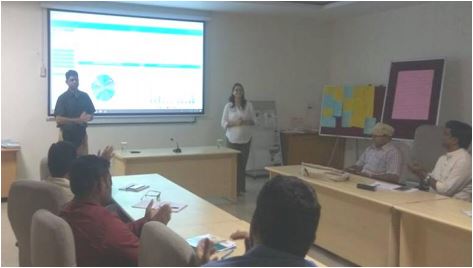 Mr Pritam K Nanda and Mrs Archana shared the success story of Digital Green, a global smallholder farmer development organization. Through their presentation, trainees developed an understanding on how participatory video making is done, the steps involved, and how activities are monitored using latest technologies like Airmore, Virtual training app, analytical board, etc. Apart from building conceptual clarity on how this initiative is operationalised at the field level, they also showed how outreach functionaries exhibit videos using Pico projectors.
Mr Pritam K Nanda and Mrs Archana shared the success story of Digital Green, a global smallholder farmer development organization. Through their presentation, trainees developed an understanding on how participatory video making is done, the steps involved, and how activities are monitored using latest technologies like Airmore, Virtual training app, analytical board, etc. Apart from building conceptual clarity on how this initiative is operationalised at the field level, they also showed how outreach functionaries exhibit videos using Pico projectors.
Session 10: Visit to Urban Farming models at MANAGE
With mounting pressure on land and rising gender issues, the Urban Farming models at MANAGE
adopted from the Asian Vegetable Research Development Centre prove to be an excellent solution to the above stated concerns. Immediately after seeing those farming models, many of the participants (being field level functionaries), were motivated to adopt models which were perceived to be suitable for their homes and workplaces. Seeing their enthusiasm, an individual exercise was assigned to the participants. The task given to them was to write a feature story and post it on social media.
Session 11: Visit to i-hub and t-hub at ICRISAT
The trainees were taken on exposure visits to i-hub and t-hub centres at the International Crops Research Institute for the Semi-Arid Tropics (ICRISAT), Patancheru, Hyderabad, to expose them to recent trends in new media for agricultural extension. With concern growing over professionalizing agriculture and attracting more youth to agriculture, innovations such as i-hub and technology incubation centres where new ideas emerge over a cup of coffee,is a positive sign. At i-hub, young professionals incubate startups in the domain of digital agriculture, while at t-hub, it is more technology oriented and work is done with inclusive market-oriented development (IMOD) models for technology upscaling. The success stories of startups – Plantix app, KEANSA, Aegis, Robotix, Nutri food basket, NaPanta Pvt. Ltd., Shri Ram, and so on–were shared by ICRISAT faculty with the trainees.
Session 12: Integrating modern new media tools in improving agricultural extension services
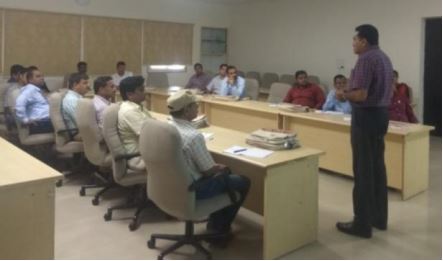 Dr C Kathiresan, Associate Professor, National Institute of Rural Development and Panchayati Raj (NIRD & PR), Hyderabad, made a presentation on Internet of Things (IoT), which is an application of New Media at field level. After he set the context for his presentation, he briefed the participants on the concept of IoT, how it evolved, and its
Dr C Kathiresan, Associate Professor, National Institute of Rural Development and Panchayati Raj (NIRD & PR), Hyderabad, made a presentation on Internet of Things (IoT), which is an application of New Media at field level. After he set the context for his presentation, he briefed the participants on the concept of IoT, how it evolved, and its
application at field level with special emphasis on Harita-Priya (Harmonized Information of Agriculture, Revenue and Irrigation for a Transformation Agenda – Precision Technology for Agriculture) project of Andhra Pradesh. The project was conceived in order to provide instant solution to farmers through SMS, after diagnosing field level problems using sensors. In conclusion he emphatically said, “If you think internet has changed your life, IoT is going to change it all over again”.
Session 13: Digital publishing platforms
Dr Srinivasacharyulu Attaluri, Program Officer, MANAGE, made a presentation on ‘Digital publishing platforms’, which can be used to share information and knowledge on the digital platform, which are advantageous over the traditional pen and paper method for storing content for more convenient future reference. After orienting the participants on the evolution of writing, he acquainted them with
the latest digital publishing platforms that can be used to reach farmers.
Group exercise and presentation by participants
A group exercise was conducted by Dr Saravanan Raj. The trainees were divided into three groups to enhance their group learning and skills on leadership and presentation. Each group was provided with two topics related to new media in agricultural extension and advisory services (AEAS), and asked to present their understanding and ideas on the given topic. During the exercise, they pooled their
experience too. As a result, groups came up with a presentation on each topic, and prepared an inventory of information in charts. The output of each group appeared in the form of web pages, Whats App messages, new media posters, selfie contest and short video clips that were presented by each group representative – and it was a visual treat to both the trainees and the organizing team. The commitment and passion shown in using new media by trainees were clearly evident from these presentations. Inter-group appreciation of these presentations will obviously help the trainees to move ahead in making their organization’s climate healthy and mutually supportive.
To measure how much of the subject matter had been actually learned by the participants, a test comprising 20 multiple choice questions was conducted at the computer hall and the individual trainee’s score was displayed on the desktop at the end of the test. Feedback was collected from the trainees at the end of the programme to further improve the structure and quality of such training programmes. The participants were also asked to contribute five ‘take home’ messages and five action points which they had acquired from this training programme. These are summarized below.
Take home messages
- Need and importance of new media in changing rural context;
- Ways to use new media as a social investment to benefit target farmers;
- Concepts of Information Technology (IT) and Information and Communication Technology (ICT);
- Cleaning laptops and personal computers regularly using simple short cuts to ensure safe and secure
use of e-resources; - Basics of various new media and its application offering agricultural extension and advisory services
(AEAS); - Do’s and Don’ts in using new media to enhance the outreach of the AEAS;
- Preparation of high quality, target-specific new media tools adopting the concept of Edgar Dale’s
Cone of Experience; - Metamorphosis of conventional agriculture to digital agriculture in the changing rural context;
- Various e-resources available to offer technologies and technical know-how to needy farmers, field
level extension functionaries, students, researchers and professionals of agriculture and allied
disciplines; - Working levels and mechanism of KCC;
- Creating and/or developing webpage, short video clips and more interactive PowerPoint
presentations; - Increasing the effectiveness of existing manpower in agriculture extension using new media tools;
- Enhancing skill in writing articles and publishing it on online platforms;
- Managing a training programme effectively in a smoother manner by skilful coordination of all the
collaborative resources.
Action points
- Implementing training management skill learned from training programme at the field level;
- Disseminating technologies using new media – forming a WhatsApp group, a Facebook group, etc., – to ease and speed up the flow of timely information;
- Continued utilization of e-resources for knowledge enrichment and skill upgradation;
- Studying suitable agMOOC courses and disseminating agMOOC courses among needy people and suitable candidates;
- With the aim of establishing incubation cells, initiate agri-business incubation activities at the work place in order to motivate new startups;
- Publishing online articles, based on field level experiences, information and success storiesso as to increase outreach within a short time;
- Production of short videos on various agricultural and allied activities which are appropriate for dissemination among farmers;
- Develop region-specific mobile app in collaboration with allied departments to meet the local needs of farmers;
- Gender mainstreaming in agriculture and allied farming activities
- Use various e-resources to get information to fortify extension and advisory service delivery;
- Popularize the activities of institutions, such as MANAGE, NAARM and ICRISAT among farmers;
- Share the knowledge and skill learned from this training programme with colleagues to make them equally competent and cooperative in enhancing training impact;
- Collaborate on various activities of allied departments through new media for effective and efficient extension service delivery;
- Sensitize and train farmers and youth for availing extension and advisory services using new media.
Valedictory session
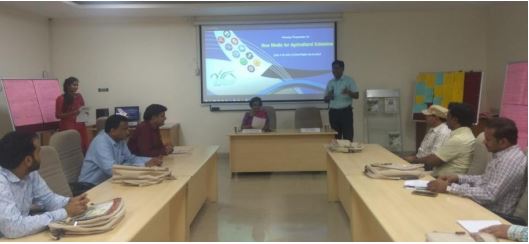 In the valedictory session, Smt. Usha Rani, IAS, Director General, MANAGE, and Dr Saravanan Raj, Director (Agril. Extension), MANAGE, were present. A short presentation was made by one of the training facilitators to give a quick recap of the five days of training. In addition to this, three participants spoke of their experiences and registered their appreciation of the training that was more practice-oriented than just being theoretical.
In the valedictory session, Smt. Usha Rani, IAS, Director General, MANAGE, and Dr Saravanan Raj, Director (Agril. Extension), MANAGE, were present. A short presentation was made by one of the training facilitators to give a quick recap of the five days of training. In addition to this, three participants spoke of their experiences and registered their appreciation of the training that was more practice-oriented than just being theoretical.
Our impressions
- The training sessions went smoothly without any snag – revealing the meticulous planning, preparation, organization and implementation behind every minute part of the programme by the organizing team. The sessions organized on training were highly informative as each session focused on bridging the information gap that exists in the public extension system by using new
media. The experts invited for various sessions shared their experiences with new media, citing field level examples, thus making it more interactive for participants, and helped them develop confidence in application of new media at the grassroots level. - The exposure visits organized as part of the training programme helped participants develop a concrete idea on how agriculture can be made more profitable through the use of ICT tools. It also provided insights on how the future of farming can be secured using new technologies like IoT (Internet of Things), drones, mobile apps, etc. The success stories documented at i-hub and t-hub centres of ICRISAT were a clear indication of using the potential of youth to develop inclusive market-oriented development models in agriculture for the betterment of the sector.
- The training group was well-balance – representing Ministry of Agriculture & Farmer Welfare, ICAR institutes, State Departments, SAUs and KVKs from ten states. This did not pose a challengeto teamwork as everybody participated in both the individual and group exercises wholeheartedly, which made the training more rewarding. Apart from giving theoretical orientation on the various topics, trainees were made to do small exercises like designing a web page, developing small videos and Power Points based on what they saw and heard during the training, writing blogs based on their experiences visiting Urban farming models at MANAGE,
etc. Organising selfie contests and PPT competitions were other attractions of the training programme, which helped to keep trainees engaged throughout the training. The trainees enjoyed the methods used, which enabled them to develop core competency in new media in agricultural extension. - Organizing such types of training is the need of the hour. With limited manpower, the future of extension and advisory services in particular, lies in the use of such innovative and new media tools. Addressing the farmers’ information needs at the right time is a major constraint in the present extension system. An important takeaway in this context,according to the participants,
was integrating new media tools like WhatsApp, Facebook and web portals into their field level activities so as to better reach the farmers. Also, as a follow-up measure the government should implement training for field level functionaries in order to make them more proficient in the use of ICT tools. This will help reduce their paper work, and at the same time make the government
machinery more transparent and accountable to the citizens, which will go far in boosting the digital India initiatives of our country. - Furthermore the creation of technically competent manpower for the use of ICT was another important takeaway message for all participants. For the academic faculty at ICAR content generation was very important. “Prior to investing on any new media, we should generate timely, relevant, location-specific content in the respective local languages so as to better reach the farmers,” they said This duty can be entrusted to the academic faculty that should be comprised of scientists, teachers, students and research scholars of ICAR.
- MANAGE, the venue of the training programme, nurtured the trainees’ learning aspirations across several hours by way of sessions, amenities and resources. Along with impressive lectures and skill teaching, the experts recommended websites and books for further knowledge enrichment. The course director distributed brochures on KrishiVikas, Impulse, Agribusiness andInnovation Platform (AIP), a bulletin on Extension NEXT, as well as participants’ contact details, to supplement present and future learning.
- The computer, library, sports, yoga and recreation facilities available inside the campus enriched the quality of leisure time spent by the trainees. Besides the masterly training programme, the comfortable accommodation, warm hospitality, delicious food and occasional showers during the training period made the life of the trainees – both during and after training hours –enjoyable.
- We, now, take the freedom to put forward some suggestions that may be helpful in improving the training programme. We are greatly thankful to the organizing team, and want them to know that they should conduct such training for longer duration as this will pave the way for greater skill development in trainees. Also, more inter-group exercises may be given to overcome clique formation that could enhance the intense flow of knowledge and experience sharing among the group members.
- We express our sincere gratitude to MANAGE for involving Research Scholars as training facilitators as they serve as platforms for enriching our learning experience. It is indeed a great opportunity to equip ourselves with the required skill-setsnecessary to organize such training programmes. No doubt, the programme has been well-organized and well-mixed with classroom
sessions, using an appropriate combination of new media tools, ‘learning by doing’ computer hall practices, mutual learning-enabled individual and group exercises, inspiring motivational lectures, cheerful rejuvenating games, and ‘seeing is believing’ exposure visits to various institutes and fields. All of these have definitely nurtured the trainees, and helped develop their competencies in understanding and using new media in agricultural extension. We will surely progress further in discharging our duties and services using new media tools for the betterment of farming.
Ms. Aswathy Chandrakumar is pursuing PhD in Agricultural Extension at Division of Dairy Extension, National Dairy Research Institute (NDRI), Karnal-132001, Haryana, India. (email: acs14292@gmail.com)
Dr MS Kannadhasan, Assistant Professor, VUTRC (TANUVAS), Dharmapuri-636701, Tamil Nadu, is
currently pursuing PhD in Veterinary Extension Education at Division of Extension Education, ICAR- Indian
Veterinary Research Institute, Izatnagar-243122,UP, India.(email: vetmskdhasan@gmail.com)


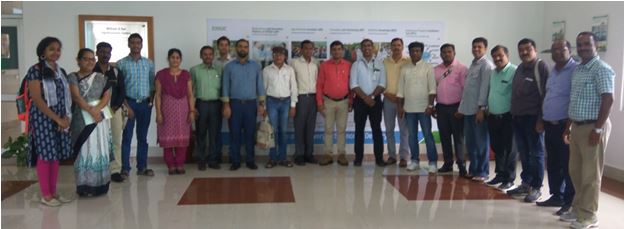


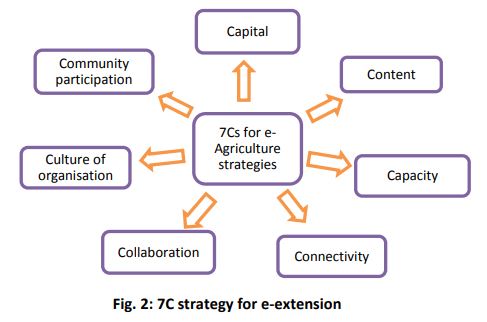
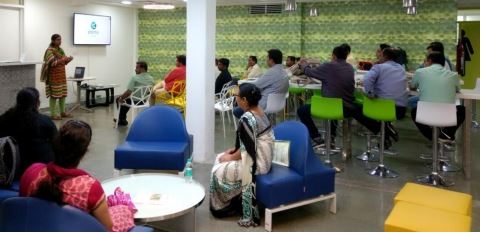
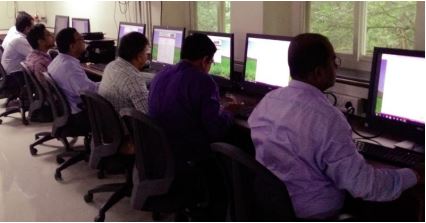
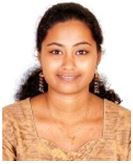
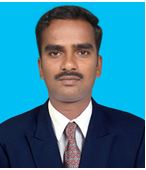
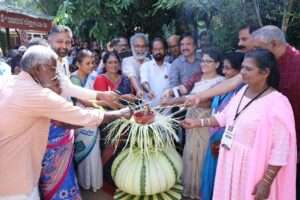

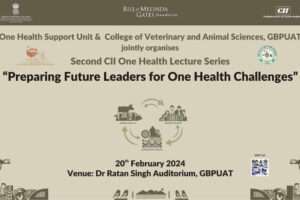
Add Comment